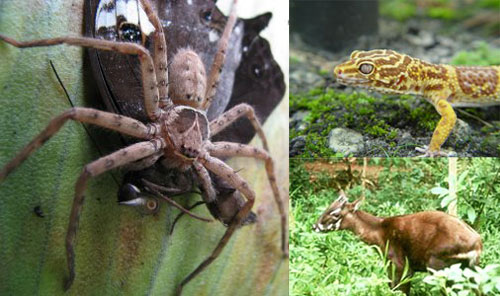Climate change threatens the Mekong region
The Mekong region is considered one of the last biodiversity areas of the planet, including five Southeast Asian countries and China's Yunnan province. If climate change continues to happen, WWF warns, 163 rare and endangered animal species are at risk of extinction.
Last week's WWF wildlife protection group said climate change is threatening 163 new species of rare species discovered last year in the Mekong region.
Frequent droughts and floods plus storm surges have become a real threat to the regional species that WWF describes as ' one of the last biodiversity areas'. of the world '. This area includes Cambodia, Laos, Myanmar, Thailand, Vietnam and Yunnan province of China.
Geoffrey Blate, WWF regional climate change coordinator, said: " The projections for the Mekong region have shown that climate change is causing the ecosystem here to be destroyed in a way. terrible '.

Spider hunters, saola, leopard geckos - endemic species in the Mekong region
" The most at-risk species are the least adaptive in terms of physiology in terms of changes in temperature and rainfall. They are cornered into increasingly narrow habitats ."
Among the most vulnerable rare species that WWF's announcement is that birds do not fly, the frogs have poisonous teeth and orange eye geckos.
According to WWF, the habitat and food needed for these species' lives are getting smaller and the situation is getting worse when the climate changes. The species that are incapable of adaptation have only one path to extinction.
With diverse topography and climate, the Mekong region is home to more than 320 million people and many rare and endemic animals such as small deer called saola and hunter spiders (huntsman spider). stride to 30 cm long.
- Ecological crisis threatens the Mekong sub-region
- Drought, saline intrusion threatens the Mekong basin
- The whole Mekong Delta is subsiding at a rate of nearly 2.5cm per year
- Climate change threatens the
- Vietnam is supported to adapt to climate change
- Mekong sub-region focuses on green growth
- Five Mekong sub-countries fight smog pollution
- Climate change 'challenges' in the Pacific region
- The Mekong Delta risks being submerged under the sea
- Denmark helps Vietnam cope with climate change
- Impact of climate change on rice granary: Do not be pessimistic
- Climate change scenario: More than 1/3 of the Mekong Delta is flooded
 Is the magnetic North Pole shift dangerous to humanity?
Is the magnetic North Pole shift dangerous to humanity? Washington legalizes the recycling of human bodies into fertilizer
Washington legalizes the recycling of human bodies into fertilizer Lightning stone - the mysterious guest
Lightning stone - the mysterious guest Stunned by the mysterious sunset, strange appearance
Stunned by the mysterious sunset, strange appearance